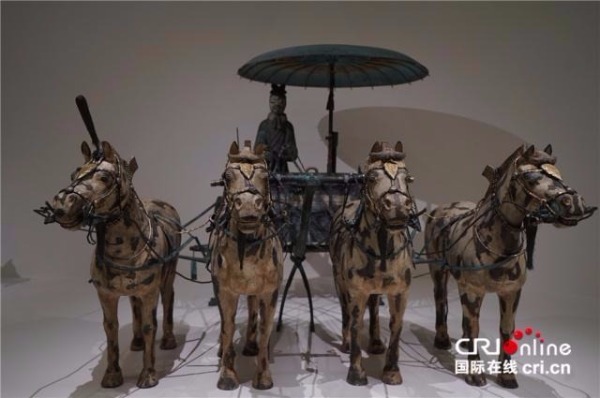 |
The exhibition, Terracotta Warriors: Guardians of Immortality/Cai Guo-Qiang: The Transient Landscape, runs from May 24 to Oct 13.[Photo/CRI online] |
Eight life-size Terracotta Warriors from China are among the works shown as part of a rare exhibition being hosted by the National Gallery of Victoria in Melbourne.
The exhibition, Terracotta Warriors: Guardians of Immortality/Cai Guo-Qiang: The Transient Landscape, runs from May 24 to Oct 13.
It offers a new perspective on China's traditional culture with more than 160 exhibits on show, including the Qin emperor's Terracotta Warriors, which were discovered in 1974 in China's northwestern Shaanxi province, and are widely described as one of the wonders of the world.
The exhibition features eight warriors and two life-size horses from the imperial army, as well as two half-size replicas of bronze chariots, each drawn by four horses.
Presented in parallel, work by contemporary artist Cai Guoqiang gives visitors a glimpse of modern Chinese art. Created specially for this exhibition, highlight pieces include the monumental installation of 10,000 suspended porcelain birds.
Spiraling over visitors' heads, the birds create a three-dimensional impression of a calligraphic drawing of the sacred Mount Lishan, the site of the ancient tomb of China's first emperor, Qin Shihuang, and his warriors.
Cheng Jingye, Chinese ambassador to Australia, said at the preview ceremony that the exhibition represents another highlight in this year's China-Australia cultural-and-arts exchange.
"I know that the Terracotta Warriors are very familiar with the journey to Australia," he says. "In 1982, to celebrate the 10th anniversary of the establishment of diplomatic relations between China and Australia, Australia was chosen as the destination for the first-ever overseas tour of the Terracotta Warriors. At that time, the figures traveled to six capital cities. In 2010, they were once again on display in the Art Gallery of New South Wales."
He notes that the Terracotta Warriors come from Shaanxi's provincial capital, Xi'an, the start of the ancient Silk Road.
While the ancient Silk Road created a means of exchange between the East and the West 2,000 years ago, the Belt and Road Initiative was launched in 2013 to achieve common development through connected global partnerships.
Last year, the Australian state of Victoria became involved with the Belt and Road Initiative. "I really look forward to seeing the initial results of this collaboration," says the ambassador.
"I strongly believe that the existing exchanges and cooperation in the fields of economy, trade, investment, education and culture between China and Victoria will make even greater progress in the future."
Xinhua